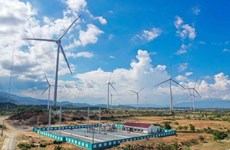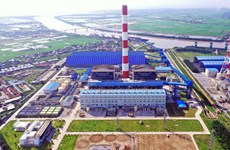Beef industry urged to undergo transformation
If the beef industry does not undergo a remarkable transformation, it
will not be sufficiently competitive with imported beef in the future to
survive, President of the Vietnam Husbandry Association Nguyen Dang
Vang told radio The Voice of Vietnam (VOV).
If the beef industry does not undergo a remarkable transformation, it
will not be sufficiently competitive with imported beef in the future to
survive, President of the Vietnam Husbandry Association Nguyen Dang
Vang told radio The Voice of Vietnam (VOV).
Vang said Vietnam has become the second largest consumer of Australian beef with 84,000 head of cattle imported since the beginning of this year, and the figure is forecast to reach 150,000 by the year-end.
The influx of Australian beef is attributed to local consumers’ increasing demand. Although imported beef is currently subject to a tax of 5 percent, it overwhelms local beef thanks to lower breeding costs and large-scale and modern breeding procedures overseas, added Tong Xuan Chinh, Deputy Head of the Animal Husbandry Department.
According to VOV, many experts worry that subsequent to Vietnam signing the Trans-Pacific Partnership (TPP) agreement, the import tax on beef will be gradually slashed to zero percent by 2018, which would reduce the cost of imported beef even further, effectively killing the beef industry in Vietnam.
Vang emphasised that the Ministry of Agriculture and Rural Development (MARD)’s project to restructure the husbandry sector aims to speed up the breeding of cows to increase the added value in agriculture. However, if the beef industry does not make remarkable changes in terms of breeding procedures, scale, and prices, local beef cannot compete with imported products.
Nguyen Do Anh Tuan, Director of MARD's Centre for Agriculture Policy Consultancy, said Vietnam’s beef industry still has plenty of time to make changes and sharpen its competitive edge.
One advantage Vietnamese beef has is that local consumers still prefer to purchase beef at traditional markets. This is a natural “shield” that serves to protect the domestic beef industry, Tuan said.
Dang Kim Son, Director General of the Institute of Policy and Strategy for Agricultural and Rural Development, in turn said the biggest hindrances to the cow breeding industry are small-scale breeding, outdated production procedures, low productivity, and lack of planning and little co-ordination in consuming products.
To get out of the woods, the industry should set up commercial cow breeding models between farmers and businesses. Getting involved in the supply chain, farmers should receive support from businesses to obtain bank loans for production. In fact, several models have proved successful in Dong Nai and Hanoi.
Apart from cooperation between businesses and banks, there should be support from the State and slaughtering establishments to establish a comprehensive production and consumption procedures, contributing to boosting the cow breeding industry and overhauling the husbandry sector.-VNA
Vang said Vietnam has become the second largest consumer of Australian beef with 84,000 head of cattle imported since the beginning of this year, and the figure is forecast to reach 150,000 by the year-end.
The influx of Australian beef is attributed to local consumers’ increasing demand. Although imported beef is currently subject to a tax of 5 percent, it overwhelms local beef thanks to lower breeding costs and large-scale and modern breeding procedures overseas, added Tong Xuan Chinh, Deputy Head of the Animal Husbandry Department.
According to VOV, many experts worry that subsequent to Vietnam signing the Trans-Pacific Partnership (TPP) agreement, the import tax on beef will be gradually slashed to zero percent by 2018, which would reduce the cost of imported beef even further, effectively killing the beef industry in Vietnam.
Vang emphasised that the Ministry of Agriculture and Rural Development (MARD)’s project to restructure the husbandry sector aims to speed up the breeding of cows to increase the added value in agriculture. However, if the beef industry does not make remarkable changes in terms of breeding procedures, scale, and prices, local beef cannot compete with imported products.
Nguyen Do Anh Tuan, Director of MARD's Centre for Agriculture Policy Consultancy, said Vietnam’s beef industry still has plenty of time to make changes and sharpen its competitive edge.
One advantage Vietnamese beef has is that local consumers still prefer to purchase beef at traditional markets. This is a natural “shield” that serves to protect the domestic beef industry, Tuan said.
Dang Kim Son, Director General of the Institute of Policy and Strategy for Agricultural and Rural Development, in turn said the biggest hindrances to the cow breeding industry are small-scale breeding, outdated production procedures, low productivity, and lack of planning and little co-ordination in consuming products.
To get out of the woods, the industry should set up commercial cow breeding models between farmers and businesses. Getting involved in the supply chain, farmers should receive support from businesses to obtain bank loans for production. In fact, several models have proved successful in Dong Nai and Hanoi.
Apart from cooperation between businesses and banks, there should be support from the State and slaughtering establishments to establish a comprehensive production and consumption procedures, contributing to boosting the cow breeding industry and overhauling the husbandry sector.-VNA












